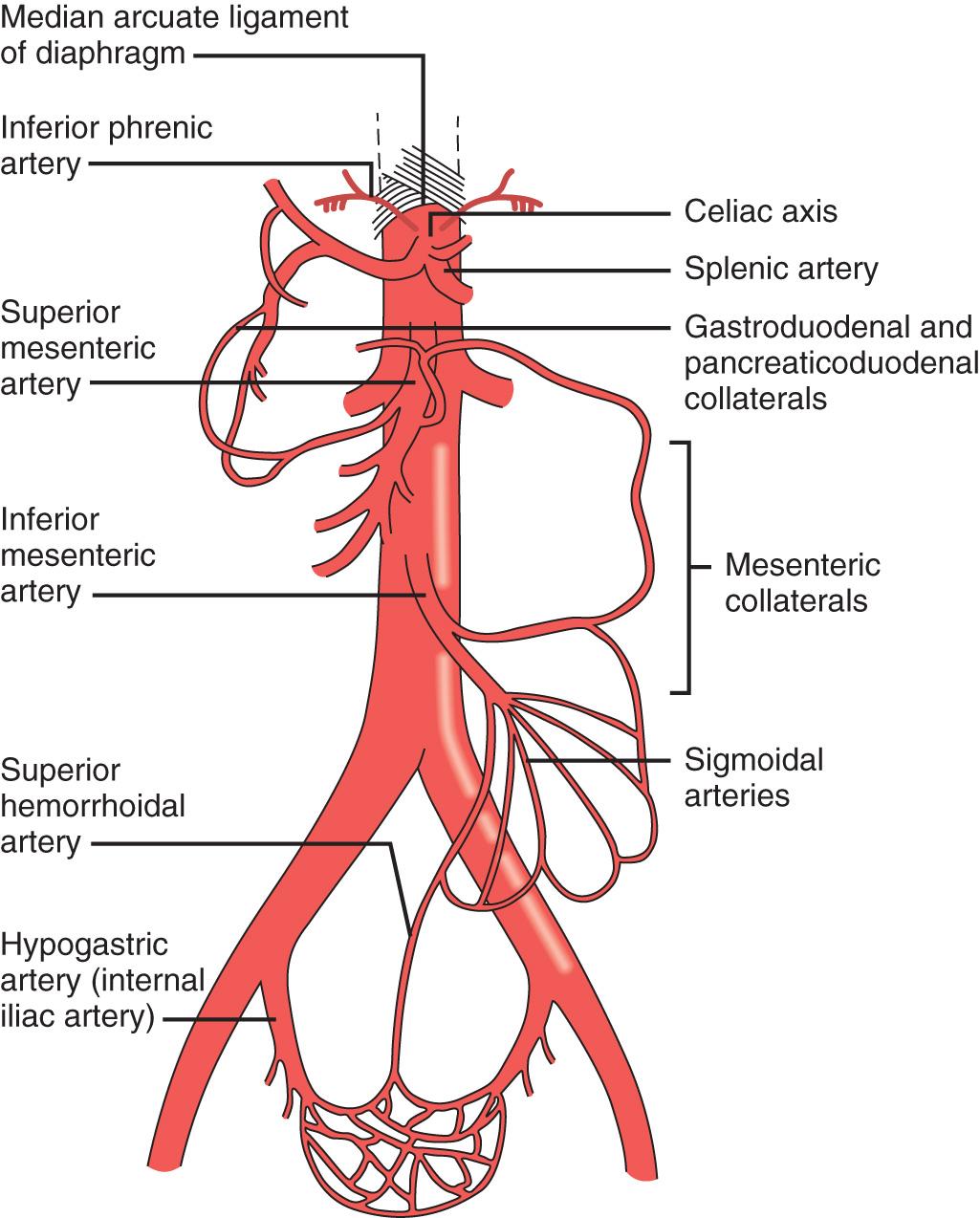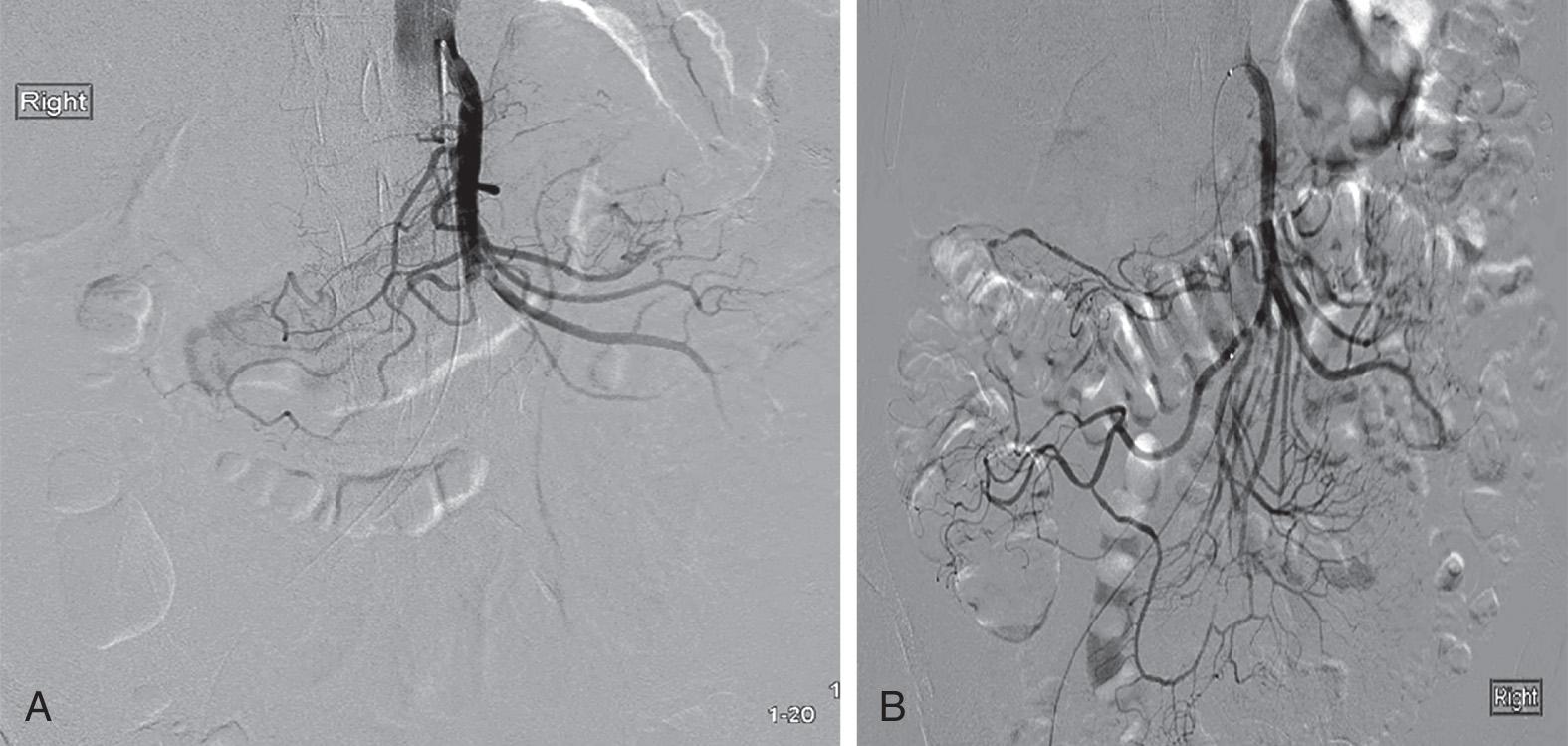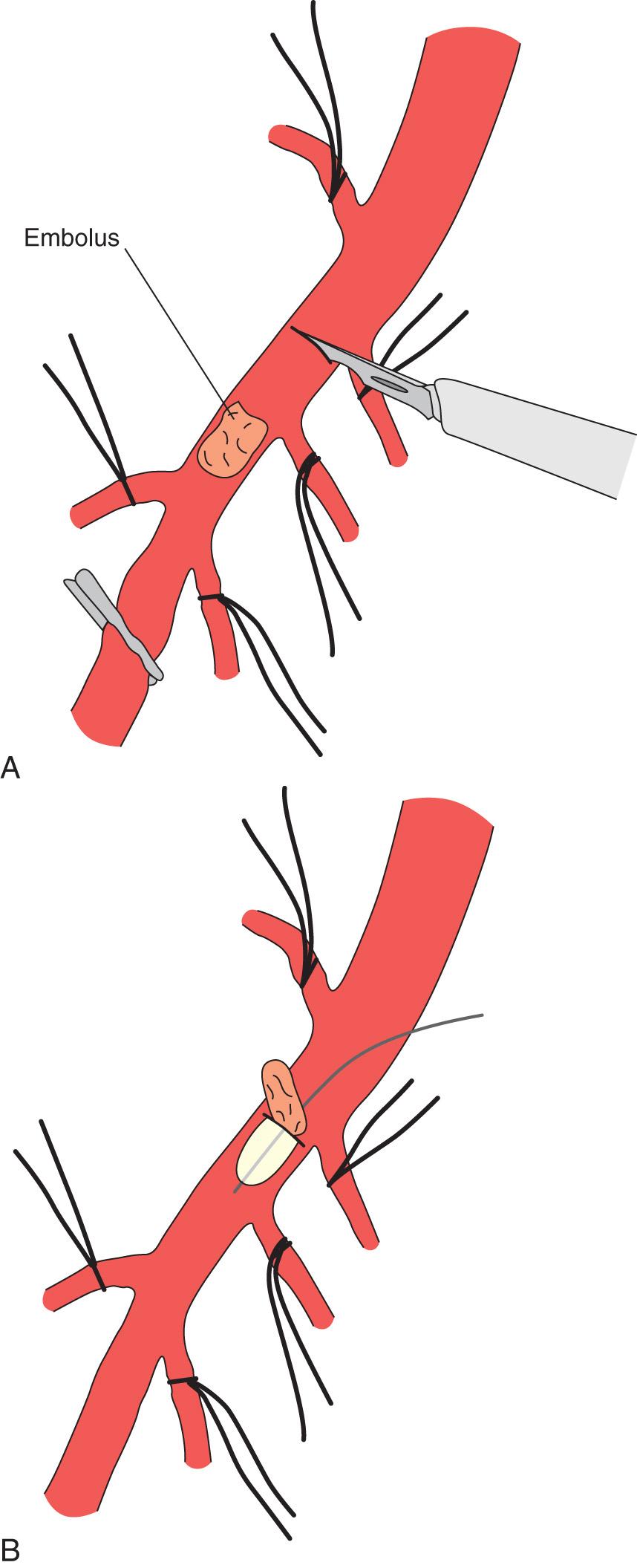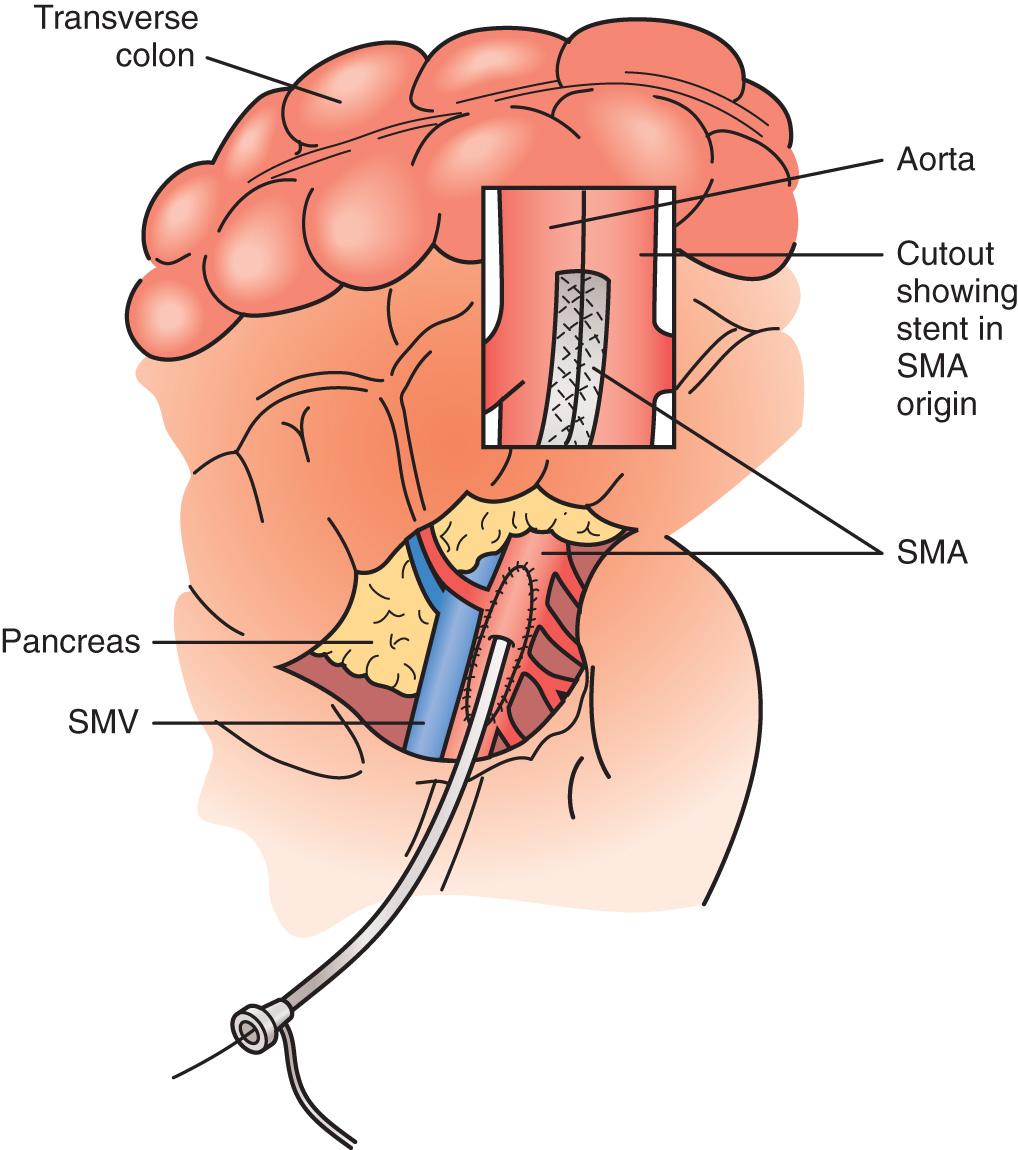Physical Address
304 North Cardinal St.
Dorchester Center, MA 02124
Mesenteric ischemia represents insufficient perfusion of the mesentery to meet the metabolic demands of the splanchnic system. Understanding the etiology and presentation of the different forms of mesenteric ischemia is pivotal to the prompt diagnosis and treatment of this often life-threatening condition, with mortality rates that can range from 24% to 94%. This chapter will separate the forms of mesenteric ischemia based on the acuity of their presentation and the nature of the underlying pathology. Mesenteric ischemia is divided into acute mesenteric ischemia (AMI) and chronic mesenteric ischemia (CMI). The four commonly identified causes of AMI include arterial embolism (AE), arterial thrombosis (AT), venous thrombosis (VT), and nonocclusive mesenteric ischemia (NOMI). CMI is attributed to atherosclerotic disease in 95% of cases, with all major mesenteric arteries demonstrating stenosis or occlusion. Other causes include forms of dissection, vasculitis, radiation, and malignancy. Findings of CMI often precede AMI, as regions of chronic narrowing are susceptible to acute chronic thrombosis, a progression that is associated with greater than 50% mortality.
Symptoms manifest in different ways based on the degree and acuity of ischemia. Each form of ischemia has its defining characteristics that affect the regions of mesentery affected, and define the treatments that are appropriate and available. AMI is frequently evaluated in the emergency department, where the patient presents after the sudden onset of abdominal pain that is classically described as “pain out of proportion” with examination. Acute presentations require rapid diagnosis to decrease mortality. Despite the best efforts of modern medicine, mortality still exceeds 50%. Factors that contribute to this high mortality rate include patient demographics and the catastrophic impact that the disease process has on multiple organ systems. Acute presentations can be difficult to identify as symptoms overlap with other conditions, and there are several disease processes that can lead to AMI. CMI is far more likely to be seen in patients who have experienced symptoms of postprandial abdominal pain, nausea, and weight loss over an extended period of time. This constellation of symptoms, frequently provoked by oral intake, results in the classically described phenomenon of food fear . CMI can be a challenging diagnosis to make, as multiple areas of arterial obstruction do not necessarily relate to degree of symptoms. Often patients with CMI have undergone evaluation by other specialists and have had prior imaging for evaluation of abdominal pain that was insufficient to identify mesenteric ischemia. Imaging, laboratory studies, and clinical examination do not have findings exclusive to either form of mesenteric ischemia, and the constellation of evaluation studies and clinical examination must be combined with an appropriately focused history and physical to guide in further assessment and care. Historically one of the earliest successful surgically treated presentations of mesenteric ischemia described in the medical literature dates back to 1895. In a remarkable case series of two surgically treated patients, Dr. Elliott became the first physician to demonstrate the utility of surgical intervention in the treatment of mesenteric ischemia. Litton, who had been cited in Elliott's work, had specifically concluded that acute occlusion by emboli would result in necrosis, whereas gradual narrowing and occlusion had previously been demonstrated by Virchow to be tolerable, and even asymptomatic, in some patients.
The standard of surgical intervention that persisted for many years involved only resection of gangrenous bowel. No attempt at restoration of perfusion had been made until 1951, when the use of surgical embolectomy was reported in the treatment of superior mesenteric artery (SMA) occlusion due to embolus from atrial fibrillation. This proved that vascular intervention decreased morbidity and mortality in a previously unsalvageable condition. Once established, options for revascularization were developed and continue to expand as modern modalities of less invasive procedures become available. Now alternatives such as stent placement and catheter directed lytic therapy are available, and the focus of clinical inquiry turns to which modality is best for each specific patient.
Blood flow to the mesentery is dependent on integrity of the three main vessels providing perfusion to the end organs of the viscera. These vessels include the celiac artery (CA), the SMA space, and the inferior mesenteric artery (IMA) space; Fig. 87.1 ). The CA supplies the foregut and originates as the first of these branches just above the renal arteries on the anterior aspect of the abdominal aorta. Flow bifurcates early and supplies portions of the stomach, pancreas, spleen, and liver. Multiple smaller branches collateralize and provide flow to portions of the duodenum and pancreas as they connect with the SMA, which is the second branch from the aorta providing flow to the mesentery. The SMA has multiple branches that provide flow to the midgut, composed of the small bowel and first portion of the colon. Importantly an early branch supplies the pancreas, duodenum, and first portion of jejunum, a crucial fact in the viable bowel left after an embolic event, as opposed to its chronic thrombotic counterpart. The IMA originates significantly lower on the aorta and brings flow to the remainder of the colon and hindgut.

Venous drainage of the mesentery runs in parallel with the arterial system although final outflow within each region drains into the portal system. Interruption in flow is affected by stenosis, hepatic resistance, intravascular devices, and thrombosis resulting from inflammation or hypercoagulable states.
Collateral blood flow provides multiple alternate pathways for perfusion of the mesentery to be preserved despite occlusions within other mesenteric vessels. Abundant collateral circulation to the stomach, duodenum, and rectum accounts for the paucity of ischemic events in these areas. The major anastomosis between the CA and the SMA is formed from the superior pancreaticoduodenal branch of the CA and the inferior pancreaticoduodenal branch of the SMA. These vessels constitute the pancreaticoduodenal arcade and provide blood to the duodenum and the pancreas. The splenic flexure and sigmoid colon have limited anastomoses, and ischemic damage is more common in these locations. There are three potential paths of communication between the SMA and IMA: the marginal artery of Drummond, which is closest to and parallel with the wall of the intestine; the central anastomotic artery or meandering mesenteric artery, a larger and more centrally placed vessel; and the arc of Riolan, an artery in the base of the mesentery. In the presence of SMA or IMA occlusion, a large collateral termed the meandering artery may be identified angiographically and represents a dilated central anastomotic artery or arc of Riolan. Chronically occluded vessels may result in retrograde flow through alternate pathways, which maintain end-organ perfusion. This expansion of collaterals takes place within the periphery as well as in response to gradual occlusion of primary flow channels. The venous system also has the ability to dilate, as flow is reestablished when a primary pathway has been occluded. Venous occlusions as observed in cirrhosis and mesenteric VT, if tolerated, can eventually develop profound alternate flow pathways.
Mesenteric blood flow is significantly influenced by autoregulation (see Chapter 86 ). Factors that diminish cardiac output may also affect mesenteric perfusion. Several medications have also been implicated for contributing to diminished mesenteric flow. Alpha antagonists frequently used within the intensive care unit to preserve blood pressure do so by vasoconstriction. In combination with poor cardiac output, they can decrease mesenteric flow to a critical level. Autoregulation and other factors decreasing flow can result in conditions such as NOMI. As the name implies, nonocclusive mesenteric ischemia does not require a fixed defect to be present for acute ischemia to develop. Understanding and recognizing the many factors that contribute to different presentations of mesenteric ischemia will aid in diagnosis and treatment.
The distinct causes of AMI include arterial and venous occlusion, and NOMI. Arterial occlusion is categorized based on the inciting cause of occlusion, embolus, or thrombosis.
AE arises frequently from cardiac sources, previously considered the most common cause of AMI, though recent studies show that AT is responsible for at least 50% of arterial AMI. Typical embolic causes include thrombus, which has accumulated in the atria due to mitral stenosis, atrial fibrillation, or within the ventricle after infarction. Septic emboli from endocarditis as well as thrombi from aneurysms, atheromatous plaques, and intravascular devices can occur. The embolic material causing AMI is most likely to lodge within the SMA due to its acute origin and high flow state. Females, who have a greater incidence of AMI due to AE, are observed to have a more acute SMA takeoff angle compared with males, which may contribute to their higher susceptibility to this condition. One-half of emboli lodge distal to the origin of the middle colic artery. This contributes to the ischemia frequently isolated to the jejunum, ileum, and ascending colon with preservation of the duodenum, and portions of proximal jejunum. Ischemia of the duodenum and proximal jejunum may also be found with emboli as 15% lodge at the SMA origin. Onset of symptoms is sudden and may be associated with a history of cardiac arrhythmias or recent myocardial infarction. Patients often describe the time or activity associated with the onset of symptoms. On physical examination, these patients are less likely to be malnourished or have other signs of CMI. The pain described is periumbilical and constant, and palpation of the abdomen is more severe than anticipated for the exam. This fits the classic description of pain out of proportion with exam. Although the appearance of rebound tenderness may be present, true peritoneal signs are a late marker of severe ischemia resulting from full-thickness ischemia or perforation. A thorough physical examination is mandatory, as other associated complications from emboli may be present, and other sources of mesenteric ischemia may have severe sequelae if not identified and addressed.
Convincing clinical examination may be enough evidence to initiate therapy in cases where laparotomy is required. Often further work-up is indicated. Laboratory studies are universally obtained and nonspecific leukocytosis is the most common early finding. Late findings include acidosis and elevated lactate levels. Multiple imaging modalities have been used to assess the acute abdomen. Abdominal plain films and ultrasounds are readily obtained in the emergency room. These studies are capable of demonstrating gross findings, but they are rarely specific. Magnetic resonance imaging (MRI) is frequently available but has longer acquisition times, overestimates stenosis, and lacks the resolution of computed tomography angiography (CTA) ( Fig. 87.2 ). Conventional angiography remains the gold standard as a diagnostic study, but its use is primarily relegated to cases where percutaneous catheter based intervention is anticipated and in the diagnosis of CMI. Conventional angiography is limited due to the availability of equipment and personnel to obtain the study in a timely fashion, and its invasive nature. For those reasons, CTA, which is readily available and has a sensitivity and specificity of 94% and 95%, respectively, has become the imaging modality of choice.

AE is a surgical emergency. Delay in intervention has a direct negative impact on patient survival. Open surgical intervention remains the standard of care for any patient who has an acute abdomen, as it permits both treatment of the inciting problem and complete evaluation of the bowel integrity. AE most frequently lodge within the SMA distal to the middle colic artery, sparing jejunal branches, and single-vessel embolectomy is capable of restoring perfusion ( Fig. 87.3 ). Full-thickness ischemia and nonviable bowel must be resected following revascularization. Bowel that is frankly perforated mandates treatment before revascularization to decrease abdominal contamination; otherwise bowel is reassessed once perfusion is restored. Minimizing bowel loss is paramount, and in many cases leaving the bowel in discontinuity with second look laparotomy is indicated to ensure bowel viability and reestablish enteric continuity more safely. Bowel reperfusion can be assessed during laparotomy by restoration of palpable pulses within the mesentery, Doppler signals along the antimesenteric border of the bowel, and overt color change observed in tissue that had been previously underperfused ( Fig. 87.4 ).


There are reports of successful catheter based interventions for restoration of perfusion with both embolectomy and catheter directed thrombolytic therapy. These interventions may be most appropriate for patients who are unable to tolerate open intervention and are unlikely to have full-thickness mesenteric injury. Endovascular intervention is limited in its ability to assess bowel viability. At this time there has been no proven mortality advantage with endovascular treatment. Studies without selection bias have not been performed, and further understanding of the appropriateness of endovascular intervention in all but selected cases is limited. A second consideration is the duration of time required for thrombolytic intervention, which could potentially perpetuate ischemia.
Thrombosis of the mesenteric vessels resulting in AMI frequently occurs within areas of arteriosclerotic narrowing at the proximal origin of the major mesenteric vessels. Patients with AT frequently have had symptoms of CMI due to progressive narrowing of the three primary mesenteric blood vessels. As occlusions are frequently an orificial process, ischemic injury is likely to affect branch vessels that embolic injury spares, resulting in more devastating bowel infarction. Ischemia may involve the duodenum and the first portion of jejunum, and result in pulselessness of the entire SMA. Distinct from embolic injury, thrombosis requires revascularization bypass around or treatment of the inflow stenosis, along with any necessary embolectomy of the distal vasculature. Multiple bypass options exist, including antegrade, retrograde, and direct aortic. These may be constructed with autogenous tissue or with prosthetic. The choice of technique and conduit used must be tailored to patient specific considerations: calcification of vessels, comorbidities, and autogenous conduit options are important factors. Full-thickness ischemia and bowel contamination would suggest the use of an autogenous conduit, but this has not been shown to change outcomes. Affected patients frequently have had little preoperative evaluation due to the acuity of their illness, so factors such as shock, myocardial dysfunction, and the physiologic stress of the procedure favor minimally invasive techniques to have an attractive role in treatment. Embolectomy techniques with retrograde stent have the potential to decrease physiologic insult and negate the need for vascular graft placement ( Fig. 87.5 ). The lower long-term effectiveness of stent placement should be balanced against its benefit in rapid restoration of blood flow during acute intervention when compared with surgical bypass options.

Become a Clinical Tree membership for Full access and enjoy Unlimited articles
If you are a member. Log in here